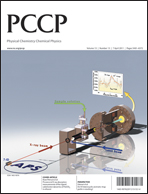The heat conductivity of liquid crystal phases of a soft ellipsoid string-fluid evaluated by molecular dynamics simulation
Abstract
We have applied a nonequilibrium molecular dynamics heat flow algorithm to calculate the heat conductivity of a molecular model system, which forms uniaxial and biaxial nematic liquid crystals. The model system consists of a soft ellipsoid string-fluid where the ellipsoids interact according to a repulsive version of the Gay–Berne potential. On compression, this system forms discotic or calamitic uniaxial nematic phases depending on the dimensions of the molecules, and on further compression a biaxial nematic phase is formed. In the discotic nematic phase, the heat conductivity has two components, one parallel and one perpendicular to the director, where the last mentioned component is the largest one. This order of magnitudes is reversed in the calamitic nematic phase. In the biaxial nematic phase there are three components of the heat conductivity, one in the direction around which the long axes of the molecules are oriented, this is the largest component, another one in the direction around which the normals of the broadsides of the molecules are oriented, this is the smallest component, and one in the direction perpendicular to these two directions with a magnitude in between those of the first mentioned components. The relative magnitudes of the components of the heat conductivity span a fairly wide interval so it should be possible to use the model to parameterise


 Please wait while we load your content...
Please wait while we load your content...